Metro Transit (Omaha)
_logo.png) | |
.jpg) | |
| Founded | 1972 |
|---|---|
| Headquarters | 2222 Cuming St, Omaha, NE 68102 |
| Locale | Omaha, Nebraska |
| Service area | Omaha–Council Bluffs metropolitan area |
| Service type | Bus service, paratransit, park and ride, bus rapid transit, streetcar (proposed) |
| Routes | 34 |
| Fleet | 135 buses |
| Fuel type | Diesel, CNG, Electric |
| Website | https://www.ometro.com/ |
Metro Transit, previously known as Metro Area Transit, is the mass transportation provider for Omaha, Nebraska. Metro currently operates around 135 buses throughout the Omaha–Council Bluffs metropolitan area, including Bellevue, Ralston, La Vista, and Papillion in Nebraska and Council Bluffs in Iowa. Operated by the Omaha Transit Authority, a governmental subdivision of the State of Nebraska, Metro's board consists of a five-member board appointed by the mayor and confirmed by the Omaha City Council and the Douglas County Commissioners. The agency receives funds from local, state, and federal sources. The city has equipped its buses with bicycle carriers and onboard Wifi. The service hours of the entire system are generally from about 4:30 am–1:00 am on weekdays, 5:00 am-midnight on Saturdays, and 6:00 am–9:30 pm on Sundays, with many routes operating a shorter span. (Some routes operate as rush hour-only, weekday-only, or Monday-Saturday only).
History
Metro Area Transit was formed in mid-1972 by the Omaha Transportation Authority from the takeover of Omaha Transit Co. and City Transit Lines, Inc. of Council Bluffs, Iowa.[1] In early 1974, Metro Area Transit began to expand into Ralston, La Vista, and Papillion.[2] By 1976, funding being with-held from the Transportation Authority threatened the Metro Area Transit from being either greatly reduced or shut down.[3] However, the Department of Labor and Transportation Authority came to an agreement, allowing for additional grants for operating.[4]
In 2002, Metro began restoring old buses into, "retro buses," for use in the system. The buses were built in the 1940s and 1950s.[5] In August 2010, Metro Area Transit officially rebranded to Metro Transit. Additionally, 24 fuel efficient buses were introduced to the system.[6]
ORBT, Omaha Rapid Bus Transit
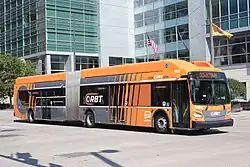
Planning for a bus rapid transit system in Omaha was listed as a priority by Regional Transit Vision as early as 2013. Work began after a $15 million TIGER grant was awarded to Omaha by the Federal Transit Administration.[7] Metro Transit unveiled the ORBT brand in August 2017.[8] Construction commenced in late 2018 and ORBT service began in fall 2020.[9]
MetroNEXT
Announced by Metro Transit on February 25, 2021, MetroNEXT is a public initiative to determine what direction Metro Transit should take in developing the existing public transit network. For some time, public input was accepted, and Metro Transit made further development into the MetroNEXT initiative. As a result, in late March 2021, round one of the initiative included a rough understanding of the individual communities and landscape that may limit service expansion and frequency. Round 2, held from mid-November to early December 2021, to frame the future of the transit network. Round 3 and 4 have yet to be held as of November 2021, but it is planned to occur in early 2022. The final plan was authorized in April 2022 by the Metro board.[10] On June 23, 2022, Metro announced a decision to transform the authority into a Regional Transit Authority to help implement the MetroNEXT Plan.[11]
Metro Flex
In August 2025, Metro Flex, an on-demand microtransit, service was launched to address the "first and last mile problem" by connecting residents to the fixed-route bus network. Operating with a fleet of eighteen new vans, the service functions similarly to ridesharing apps, allowing users to book a ride through the "Metro Flex OMA" application. This service transports passengers from their location to a bus route or any other destination within the same zone, with a guarantee of available wheelchair-accessible vehicles. According to Metro Transit CEO Lauren Cencic, the initiative is intended to fill gaps within the existing transit system and expand to meet the community's evolving needs. The service was offered for free for the first two months, with a fare of $3 or $4.25 per ride implemented after October 15.[12]
Transit Centers
Transit Centers in Omaha are an important part of Metro's system. Since 2006, many transit centers have been built or removed. Those removed were the Crossroads Transit Center in 2006, the Stockyards Transit Center in South Omaha which was replaced by Metro College Transit Center in 2007 and the Benson Park Transit Center in 2020. Others added were the Westroads Transit Center near Westroads Mall. Two other major meeting places recently upgraded to transit Center status are the Aksarben Transit Center in south central Omaha, and 76th Street Transit Center near Crossroads Mall. Both are not currently equipped with all of the amenities typically expected of a transit center, but are planned for upgrade. As of December 2012, Omaha's most used transit center, North Omaha Transit Center, has been rebuilt. Currently being phased out as construction nears, a new Downtown Transit Center is planned for the area.
Current Transit Centers (2022)
- Aksarben Transit Center - This transit center is located at 6801 Mercy Road and consists of two shelters with benches and bike racks serving 5 routes. The center opened on January 20, 2019, replacing the former Bergan Mercy Transit Center.[13]
- North Omaha Transit Center - This transit center is located at 4308 North 30th Street and consists of 14 bus bays with a covered platform and indoor waiting area serving 10 routes.
- South Omaha Transit Center - This transit center is located at 2801 Babe Gomez Boulevard and consists of 8 bus bays serving 5 routes.
- Westroads Transit Center - This transit center is located at 1099 N 102nd Street and consists of 6 covered bus bays serving 5 routes.
Fleet
| Fleet number(s) | Photo | Model Year | Manufacturer | Model | Engine | Transmission |
|---|---|---|---|---|---|---|
| 1001-1010 | 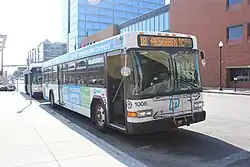
|
2010 | Gillig | Low Floor 40' | Cummins ISL9 | Voith D864.5 |
| 1011-1024 | 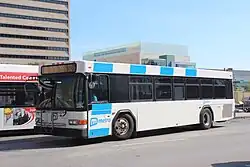
|
Low Floor 35' | ||||
| 1101-1104 | 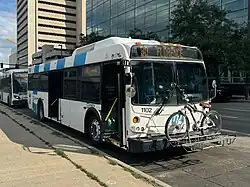
|
2011 | New Flyer | D35LFR | ||
| 1105-1109 | 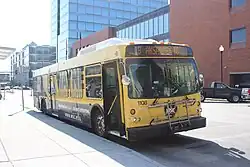
|
D40LFR | ||||
| 1301 | XD35 | |||||
| 1302-1304 | 2012 | |||||
| 1305-1308 | 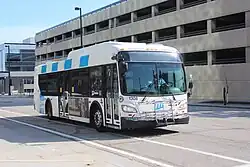
|
2013 | ||||
| 1401-1410 | 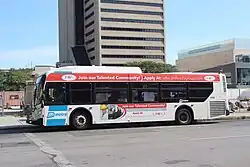
|
2014 | ||||
| 1501 | 2015 | MD30 | Cummins ISB6.7 | Allison B300R | ||
| 1502-1505 | 2016 | |||||
| 1801-1814 | 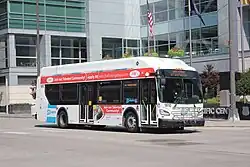
|
2017 | XN35 | Cummins Westport ISL G NZ | Voith D864.6 | |
| 1815-1819 | 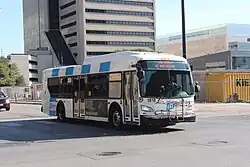
|
2018 | XD35 | Cummins L9 | ||
| 1820-1835 | 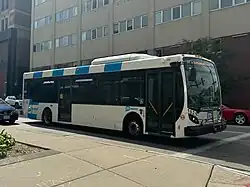
|
Alexander Dennis | Enviro200 35' | Allison B300R | ||
| 1836-1840 | 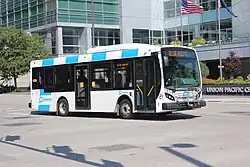
|
Enviro200 30' | Cummins B6.7 | |||
| 1901-1910 | 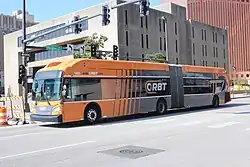
|
2020 | New Flyer | XN60 | Cummins Westport L9N | Allison B500R |
| 2051-2061 | 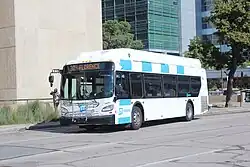
|
2021 | XN35 | Voith D864.6 | ||
| 2121-2123 | 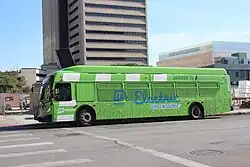
|
2022 | XE40 | Siemens ELFA2 | Direct drive |
Fixed Route Ridership
The ridership and service statistics shown here are of fixed route services only and do not include demand response. Per capita statistics are based on the Omaha urbanized area as reported in NTD data. Starting in 2011, 2010 census numbers replace the 2000 census numbers to calculate per capita statistics.[14]
| Ridership | Change | Ridership per capita | |
|---|---|---|---|
| 2002 | 3,457,539 | n/a | 5.52 |
| 2003 | 3,253,923 | 5.19 | |
| 2004 | 3,209,735 | 5.12 | |
| 2005 | 3,297,973 | 5.26 | |
| 2006 | 3,599,193 | 5.74 | |
| 2007 | 3,710,238 | 5.92 | |
| 2008 | 3,947,938 | 6.3 | |
| 2009 | 3,675,281 | 5.87 | |
| 2010 | 3,746,554 | 5.98 | |
| 2011 | 4,000,853 | 5.52 | |
| 2012 | 4,225,033 | 5.83 | |
| 2013 | 4,178,318 | 5.76 | |
| 2014 | 4,043,609 | 5.58 | |
| 2015 | 3,780,469 | 5.21 | |
| 2016 | 3,623,071 | 5.0 | |
| 2017 | 3,592,502 | 4.96 | |
| 2018 | 3,409,221 | 4.7 | |
| 2019 | 3,267,845 | 4.51 | |
| 2020 | 2,127,352 | 2.93 | |
| 2021 | 2,084,221 | 2.87 | |
| 2022 | 2,634,015 | 3.63 |
See also
References
- ^ "Erdman 'Good Choice' As New Bus Director". Omaha World-Herald. 1972-06-13. p. 14. Retrieved 2025-08-02.
- ^ "MAT Buying 10 Buses, Adding Crosstown Routes". Omaha World-Herald. 1974-02-09. p. 13. Retrieved 2025-08-03.
- ^ "Good Chance MAT Money To Be Freed". Omaha World-Herald. 1976-03-18. p. 1. Retrieved 2025-08-03.
- ^ "Accird Expected To Keep Buses Rolling for MAT". Omaha World-Herald. 1976-03-27. p. 13. Retrieved 2025-08-03.
- ^ "First retro buses debut in downtown". Omaha World-Herald. 2004-04-19. p. 1. Retrieved 2025-08-03.
- ^ "MAT hopes riders will like new 'Metro' name, logo and buses". Omaha World-Herald. 2010-08-24. p. 12. Retrieved 2025-08-03.
- ^ "Grant brings $15 million for express bus route". Hearst Television Inc. KETV. September 16, 2014. Retrieved May 24, 2018.
- ^ Starling, Nick (August 16, 2017). "Bus rapid transit system, ORBT enters next phase". Scripps Media, Inc. KMTV. Retrieved May 24, 2018.
- ^ "Rapid transit arrives in Omaha with launch of ORBT". Mass Transit. 2020-11-18. Retrieved 2025-08-01.
- ^ "MetroNEXT". Metropolitan Transit Authority of Omaha. Retrieved June 28, 2022.
- ^ "Metro looks to the future with move to a Regional Metropolitan Transit Authority". Metropolitan Transit Authority of Omaha. 23 June 2022. Retrieved June 28, 2022.
- ^ Babb, Sydney (2025-08-13). "Omahans respond to new micro-transit service, Metro Flex". www.wowt.com. Retrieved 2025-08-19.
- ^ Saladee, Shea. "Metro opens Aksarben Transit Center". KETV7. Retrieved June 28, 2022.
- ^ "The National Transit Database (NTD)". Retrieved June 29, 2022.